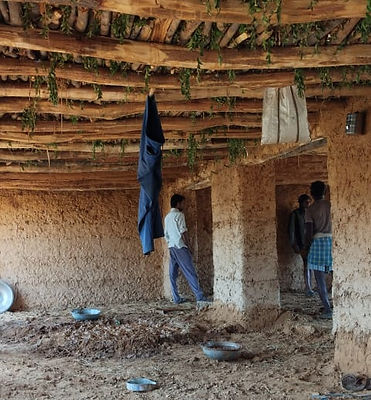

Goat Enterprise


Native to the Etawah region of Uttar Pradesh, the Jamnapari goat is celebrated for its dual-purpose
excellence in milk and meat production as well as its cultural significance. It is an endangered species due to its over exploitations


Stables built for the goats using sustainable practices




Reviving a Legacy: The Jamnapari Goat
The Pride of Uttar Pradesh
Native to the Etawah region of Uttar Pradesh, the Jamnapari goat is one of India’s most celebrated livestock breeds. Revered for its distinctive features and dual-purpose utility, the Jamnapari stands out not only for its superior meat yield but more importantly, for its rich, nutrient-dense milk. This makes it an ideal foundation for producing premium goat cheese, a product gaining strong global and domestic momentum.
Recognised in international markets—such as Indonesia, where it is affectionately known as the "Etawah" goat—Jamnapari’s genetic and nutritional excellence is unmatched. Its milk is naturally high in calcium, protein, and essential vitamins, giving cheese produced from it a creamy texture, complex flavour profile, and heightened nutritional value. These unique organoleptic qualities make it especially well-suited for artisanal cheese-making.
A Gourmet Opportunity: Artisanal Goat Cheese in India
Market Context and Vision
India’s dairy sector is undergoing a premiumization shift. As urban consumers become more health-conscious and exposed to global food cultures, the demand for gourmet, healthy, and sustainably produced cheese is rapidly rising. Artisanal goat cheese—particularly one rooted in cultural authenticity and regenerative practices—is well-positioned to become a leading product in this evolving market.
Regenerate India’s goat cheese initiative combines traditional heritage and modern craftsmanship, modelled on globally successful cooperatives like Amul, while integrating international expertise from a U.S. partner with 60 years in goat farming and 30 years in artisanal cheese production.
Unique Market Proposition
1. Distinctive Raw Material
The use of Jamnapari goat milk, with its superior quality, gives the cheese a naturally luxurious character that is both rare and culturally resonant. It serves as a key differentiator in the increasingly competitive gourmet segment.
2. Deep Expertise & Proven Know-how
The strategic collaboration with an established U.S. artisanal cheesemaker provides access to world-class processes, ensuring consistency, traceability, and quality, crucial factors for breaking into premium domestic and international markets.
3. Consumer Trends Supporting Growth
-
Rapid urbanisation and rising disposable incomes are driving demand for gourmet and health-oriented products.
-
Goat cheese, with its lower lactose content and higher digestibility, appeals to wellness-focused consumers.
-
Sustainability-conscious buyers value the product’s farm-to-table transparency, especially when supported by a Farmer Producer Organisation (FPO) model.
Market Size and Scalability
-
The global artisanal cheese market is expected to grow at a CAGR of 7–8%, while India’s premium dairy sector is expanding at 12–15% annually.
-
Within metropolitan India alone, there is potential for a $500 million niche market for artisanal cheeses over the next 5–7 years.
-
A high-quality, heritage-based goat cheese could command a 30–50% premium over conventional dairy products, with strong potential for export and luxury foodservice applications.
Revenue Potential & Long-Term Impact
-
Primary Revenue: Premium artisanal goat cheese sold through gourmet retailers, hospitality, and direct-to-consumer channels.
-
By-products: Cheese spreads, culinary ingredients, and seasonal specialities add further product diversity.
-
Agri-tourism Synergy: The project offers experiential tourism linked to food production and cultural exchange, providing an additional revenue stream.
-
FPO-Driven Growth: By aggregating local farmers into a shared value ecosystem, the model promotes inclusive growth, job creation, and rural economic resilience.
Strategic Roadmap
-
Year 1–2: Launch pilot production, scale Jamnapari herds, and establish core processing infrastructure.
-
Year 3–4: Expand product lines, enter domestic gourmet markets, initiate exports, and host cultural tourism events.
-
Year 5: Achieve operational scale with projected annual revenues of $10–15 million and establish India’s reputation as a global player in artisanal goat cheese.
This initiative is more than a product launch—it’s a renaissance of Indian agricultural heritage, innovation, and entrepreneurship. By combining the rich legacy of the Jamnapari goat with modern regenerative agriculture and global cheesemaking expertise, this project unlocks a high-margin, sustainable industry with global relevance.

